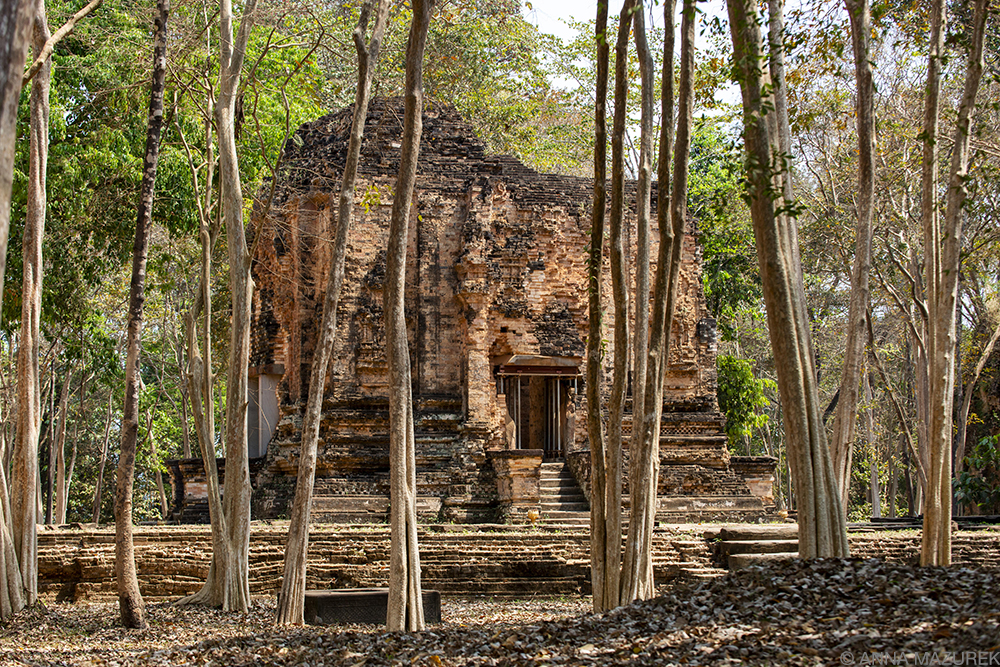
The UNESCO site of Sambor Prei Kuk is complex of more than 180 singular brick temples dedicated to the Hindu deity Shiva. These pre-Angkorian temples are the highest and biggest brick towers in the Cambodia.
My first travel story for National Geographic was published online in early April! Since I always share my pitching success stories with a business class I teach at Texas State University called Freelancing for Media Professionals, I thought it might be fun to share it as a blog post as well. If you liked this, let me know, and I’ll include more posts like this!
NOTE: While cold pitching does work, the most effective way to get work as a freelancer is to have steady anchor clients. For me, this is usually an editor who assigns me stories or one that I know well enough will approve the majority of my pitches.
The Published Story
https://www.nationalgeographic.com/travel/article/alternatives-to-angkor-wat
Background Context
I’ve lived and worked in Southeast Asia off and on since 2009 for various jobs but mostly for travel companies running photo trips. I know the region extremely well, and I’m obsessed with ruins. There is nothing I’d rather visit or photograph. I find beauty in the decay.
Since I’ve been to Angkor Wat many times, I started seeking out nearby lesser-known temples that are equally as amazing but deserted. There are four temples mentioned in the story that I had previously visited either on my own or on a road trip with an archeologist coworker. While these visits were just for fun, I was inspired by how magical it was to visit these temples without the tourist throngs. I initially pitched another publication first (AFAR), but they weren’t accepting pitches at the time.
Two timely events in the fall inspired me to keep pitching it—the opening of the new Siem Reap airport and the addition of the Koh Ker site to the UNESCO World Heritage List. I did some research and realized that Nat Geo hadn’t covered Cambodia in several years. My goal was to use a timely angle to share a different way to experience a popular tourist destination. (The airport was initially in my lede but was cut during edits.)
(For the record, I think Angkor Wat is worth visiting. These other temples can provide more context and background about the history of the Khmer Empire. Plus, it’s a more enjoyable experience to have these places to yourself than to battle thousands of tourists for a photo.)
Pitch Format
The editor I pitched was very vocal on X (formerly Twitter) about her preferred pitch format, so I followed that exactly. (Since my editor moved to a new beat, I removed her name from the pitch so she doesn’t get spammed with travel pitches.) I didn’t know her beforehand, so this was a cold pitch. It was a bit longer than normal to introduce myself.
Her pitch format from a X (formerly Twitter) post:
My ideal pitch, in this order, is:
- Sample hed/dek: if you can’t figure this out, you have a topic not a story
- Nut graph: The 5 W’s, emphasis on the WHY ARE TELLING THIS STORY NOW (superlatives, global appeal, new take, timely news, etc)
- Bio/clips
That’s it.
The Pitch
Subject Line: Timely Pitch: What Cambodia’s Hidden Temples (and a new UNESCO site) can teach us about the Khmer Empire
Hi XXXX,
I’m a freelance writer (The Washington Post, Texas Monthly) based between Austin, Texas, and Southeast Asia. I wanted to reach out with a timely pitch about Cambodia.
Headline: Looking to escape the crowds at Angkor Wat? Try these four hidden temples.
Dek: Four lesser-visited temples, including a new UNESCO site, provide a deeper understanding of Cambodia’s Khmer Empire.
Cambodia’s tourism industry is hoping tourism numbers will return to pre-pandemic levels thanks to two big announcements this fall. First was the addition of Koh Ker — Southeast Asia’s only stepped pyramid temple — to the UNESCO World Heritage List. Koh Ker is known for its unique architectural style and water-management engineering, and as a one-time capital of the Khmer Empire, it’s one of many architecturally and historically significant temples near Siem Reap. The second big announcement was the mid-November inauguration of the new Siem Reap-Angkor International Airport, which will accommodate larger passenger planes and provide easier access to the region’s temples for up to seven million people annually.
Lacking the name recognition of nearby Angkor Wat, Koh Ker and other temples are often deserted during peak season and prime locations to beat the crowds. These include Sambor Prei Kuk, a complex of over 180 sixth-century Hindu temples that inspired the Angkorian architectural style; Preah Vihear, an 11th-century mountain-top Hindu temple with a unique north-south orientation; and Banteay Chhmar, a 12th-century Angkorian temple famous for bas-relief wall panels.
For this story, I’d like to dive into the significance of each of the four temples and how visiting can increase understanding of the Khmer Empire, featuring interviews with Angkor archeologists.
Biography & Clips: I have a master’s degree in journalism from the University of Missouri. I encourage you to view my writing portfolio but specifically wanted to share a few clips from The Washington Post, including pieces on national monuments in New Mexico, the history of Croatia’s Istrian peninsula and Marfa, Texas.
Would this be a good fit?
Thank You,
Anna
Timeline and Pay Rates
Pitch Submitted: December 5, 2023
Assigned: December 18, 2023
Story Submitted: January 4, 2024
Paid: February 20, 2024
Publication Date: April 4, 2024
During the editing process, my editor switched beats, which I believe is part of the reason that my story was delayed from February until April. The deadline was January 15, but I submitted it early before an upcoming work trip.
For web travel stories, National Geographic pays $1/word. I made $800 for this 800-word article. This rate has been publicly shared online by editors, so it’s common knowledge. Their contract is work-for-hire. For the photography, I was paid a per image rate for usage only with the story. Photos were selected the week before publication, and I was paid two weeks after publication. They were buying my stock images that I had shot previously when visiting the temples.

